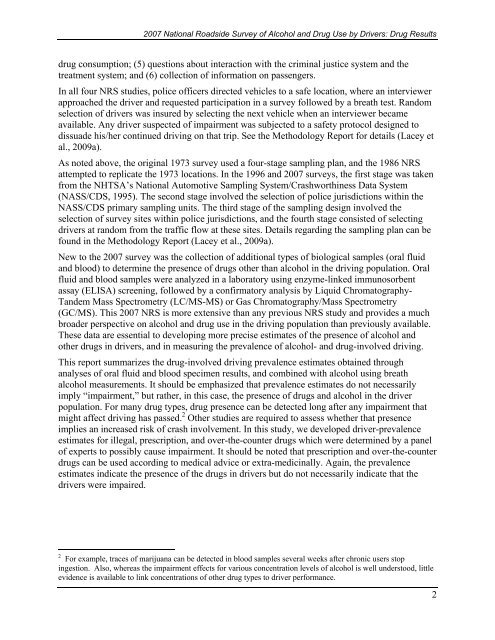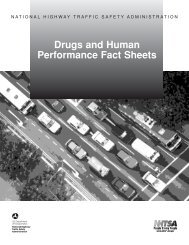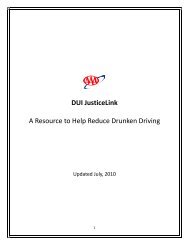2007 National Roadside Survey of Alcohol and Drug Use by Drivers
2007 National Roadside Survey of Alcohol and Drug Use by Drivers
2007 National Roadside Survey of Alcohol and Drug Use by Drivers
You also want an ePaper? Increase the reach of your titles
YUMPU automatically turns print PDFs into web optimized ePapers that Google loves.
<strong>2007</strong> <strong>National</strong> <strong>Roadside</strong> <strong>Survey</strong> <strong>of</strong> <strong>Alcohol</strong> <strong>and</strong> <strong>Drug</strong> <strong>Use</strong> <strong>by</strong> <strong>Drivers</strong>: <strong>Drug</strong> Resultsdrug consumption; (5) questions about interaction with the criminal justice system <strong>and</strong> thetreatment system; <strong>and</strong> (6) collection <strong>of</strong> information on passengers.In all four NRS studies, police <strong>of</strong>ficers directed vehicles to a safe location, where an interviewerapproached the driver <strong>and</strong> requested participation in a survey followed <strong>by</strong> a breath test. R<strong>and</strong>omselection <strong>of</strong> drivers was insured <strong>by</strong> selecting the next vehicle when an interviewer becameavailable. Any driver suspected <strong>of</strong> impairment was subjected to a safety protocol designed todissuade his/her continued driving on that trip. See the Methodology Report for details (Lacey etal., 2009a).As noted above, the original 1973 survey used a four-stage sampling plan, <strong>and</strong> the 1986 NRSattempted to replicate the 1973 locations. In the 1996 <strong>and</strong> <strong>2007</strong> surveys, the first stage was takenfrom the NHTSA’s <strong>National</strong> Automotive Sampling System/Crashworthiness Data System(NASS/CDS, 1995). The second stage involved the selection <strong>of</strong> police jurisdictions within theNASS/CDS primary sampling units. The third stage <strong>of</strong> the sampling design involved theselection <strong>of</strong> survey sites within police jurisdictions, <strong>and</strong> the fourth stage consisted <strong>of</strong> selectingdrivers at r<strong>and</strong>om from the traffic flow at these sites. Details regarding the sampling plan can befound in the Methodology Report (Lacey et al., 2009a).New to the <strong>2007</strong> survey was the collection <strong>of</strong> additional types <strong>of</strong> biological samples (oral fluid<strong>and</strong> blood) to determine the presence <strong>of</strong> drugs other than alcohol in the driving population. Oralfluid <strong>and</strong> blood samples were analyzed in a laboratory using enzyme-linked immunosorbentassay (ELISA) screening, followed <strong>by</strong> a confirmatory analysis <strong>by</strong> Liquid Chromatography-T<strong>and</strong>em Mass Spectrometry (LC/MS-MS) or Gas Chromatography/Mass Spectrometry(GC/MS). This <strong>2007</strong> NRS is more extensive than any previous NRS study <strong>and</strong> provides a muchbroader perspective on alcohol <strong>and</strong> drug use in the driving population than previously available.These data are essential to developing more precise estimates <strong>of</strong> the presence <strong>of</strong> alcohol <strong>and</strong>other drugs in drivers, <strong>and</strong> in measuring the prevalence <strong>of</strong> alcohol- <strong>and</strong> drug-involved driving.This report summarizes the drug-involved driving prevalence estimates obtained throughanalyses <strong>of</strong> oral fluid <strong>and</strong> blood specimen results, <strong>and</strong> combined with alcohol using breathalcohol measurements. It should be emphasized that prevalence estimates do not necessarilyimply “impairment,” but rather, in this case, the presence <strong>of</strong> drugs <strong>and</strong> alcohol in the driverpopulation. For many drug types, drug presence can be detected long after any impairment thatmight affect driving has passed. 2 Other studies are required to assess whether that presenceimplies an increased risk <strong>of</strong> crash involvement. In this study, we developed driver-prevalenceestimates for illegal, prescription, <strong>and</strong> over-the-counter drugs which were determined <strong>by</strong> a panel<strong>of</strong> experts to possibly cause impairment. It should be noted that prescription <strong>and</strong> over-the-counterdrugs can be used according to medical advice or extra-medicinally. Again, the prevalenceestimates indicate the presence <strong>of</strong> the drugs in drivers but do not necessarily indicate that thedrivers were impaired.2 For example, traces <strong>of</strong> marijuana can be detected in blood samples several weeks after chronic users stopingestion. Also, whereas the impairment effects for various concentration levels <strong>of</strong> alcohol is well understood, littleevidence is available to link concentrations <strong>of</strong> other drug types to driver performance.2




